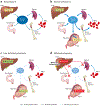Iron Homeostasis During Pregnancy: Maternal, Placental, and Fetal Regulatory Mechanisms
- PMID: 37253681
- PMCID: PMC10723031
- DOI: 10.1146/annurev-nutr-061021-030404
Iron Homeostasis During Pregnancy: Maternal, Placental, and Fetal Regulatory Mechanisms
Abstract
Pregnancy entails a large negative balance of iron, an essential micronutrient. During pregnancy, iron requirements increase substantially to support both maternal red blood cell expansion and the development of the placenta and fetus. As insufficient iron has long been linked to adverse pregnancy outcomes, universal iron supplementation is common practice before and during pregnancy. However, in high-resource countries with iron fortification of staple foods and increased red meat consumption, the effects of too much iron supplementation during pregnancy have become a concern because iron excess has also been linked to adverse pregnancy outcomes. In this review, we address physiologic iron homeostasis of the mother, placenta, and fetus and discuss perturbations in iron homeostasis that result in pathological pregnancy. As many mechanistic regulatory systems have been deduced from animal models, we also discuss the principles learned from these models and how these may apply to human pregnancy.
Keywords: hepcidin; inflammation; iron; iron deficiency; placenta; pregnancy.
Figures


References
Publication types
MeSH terms
Substances
Grants and funding
LinkOut - more resources
Full Text Sources
Research Materials

